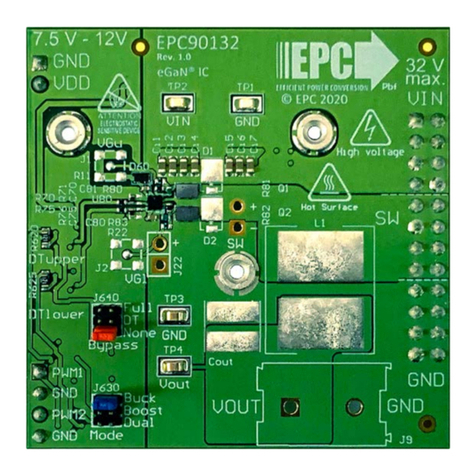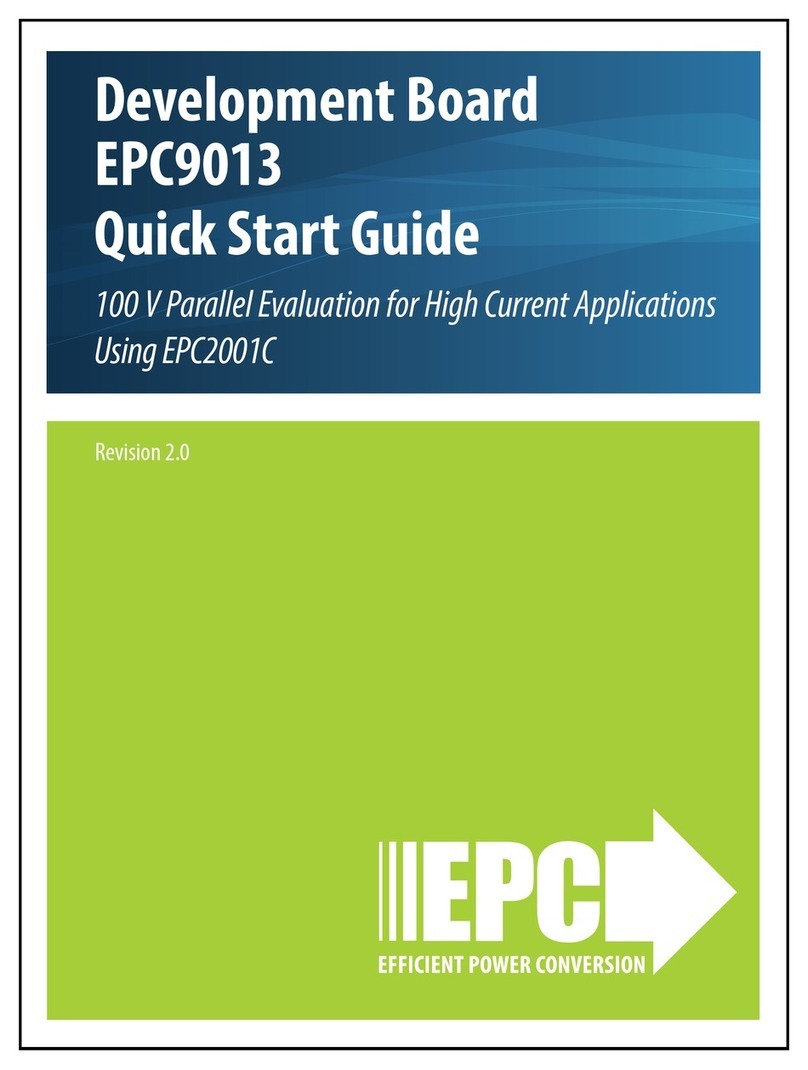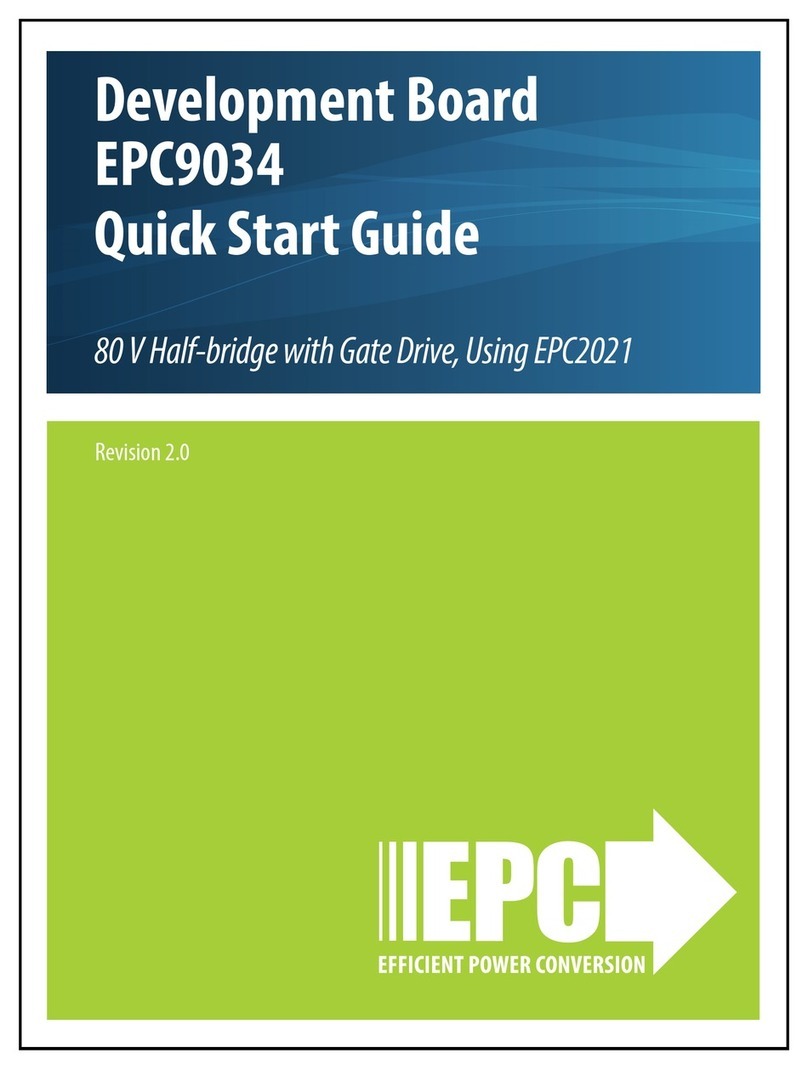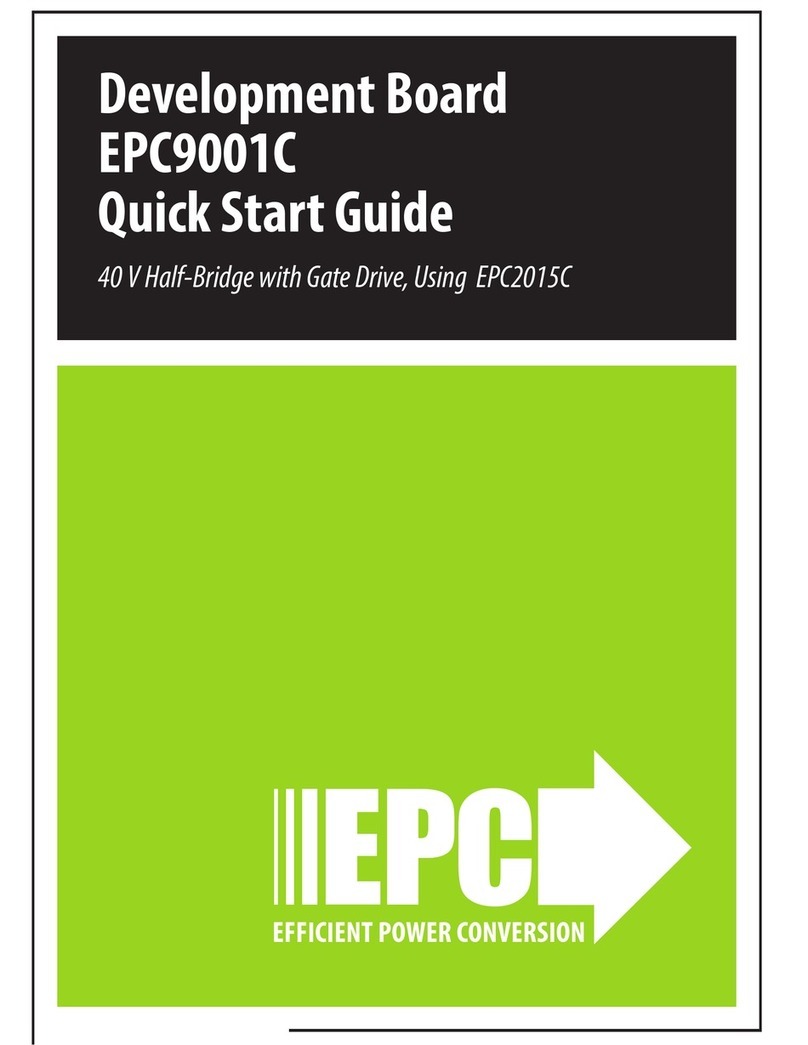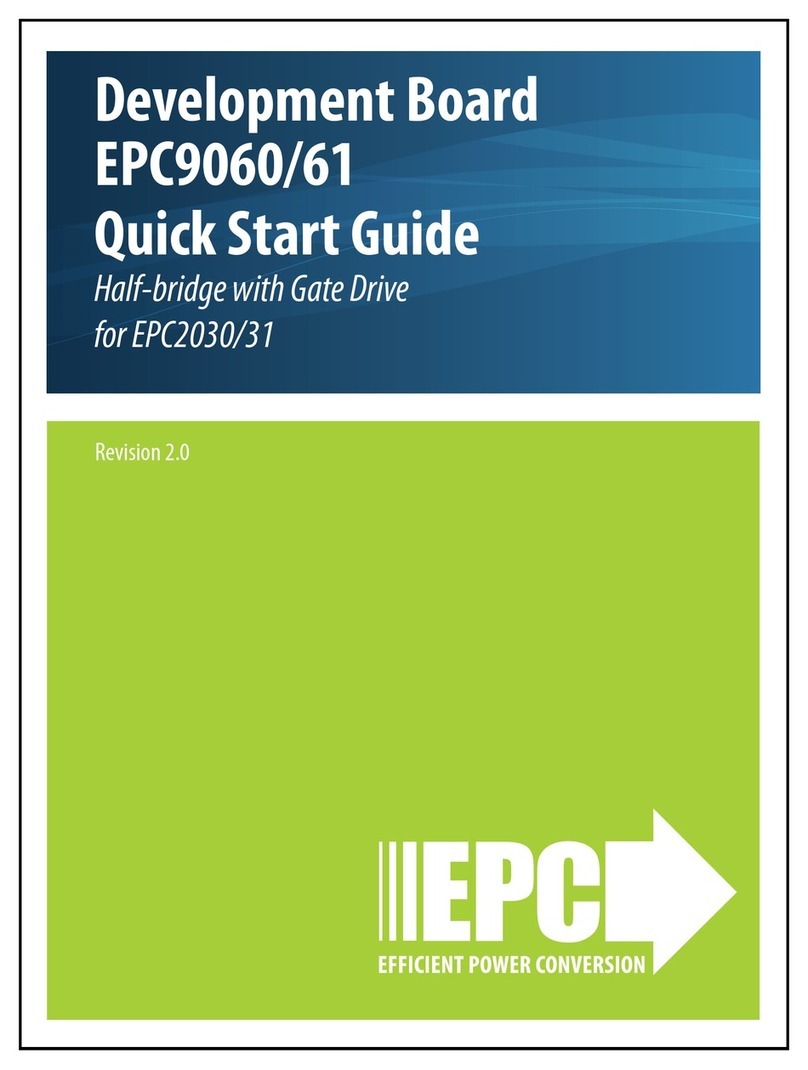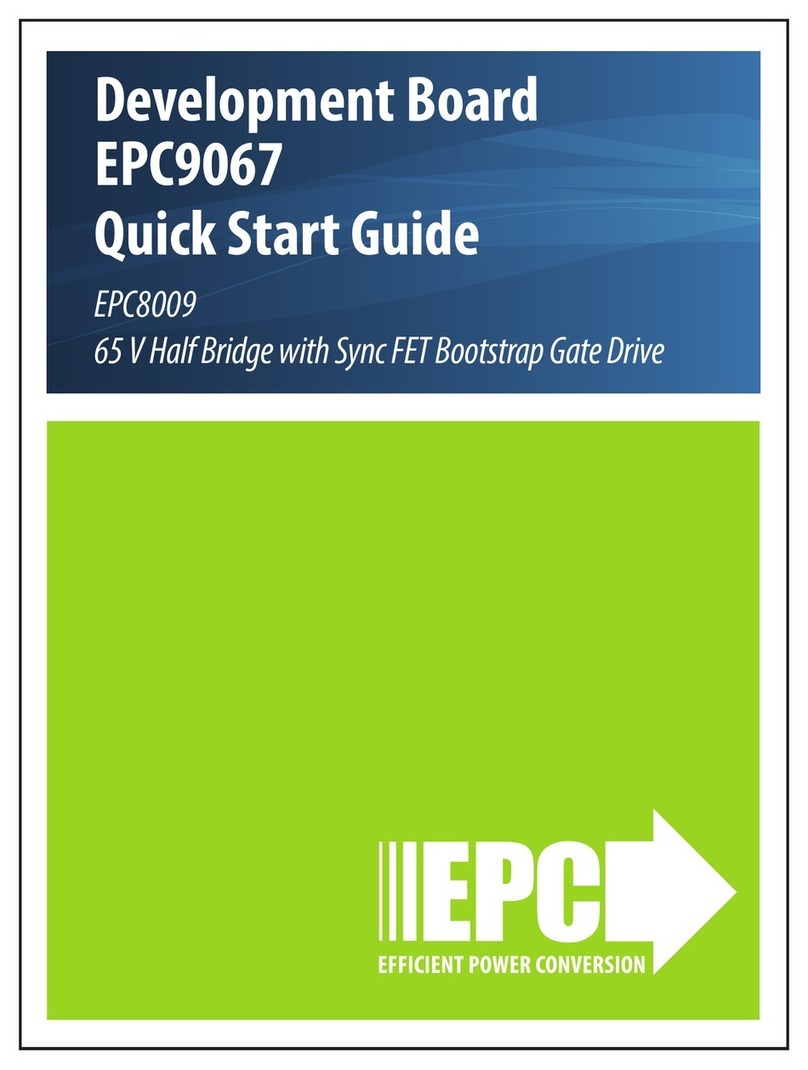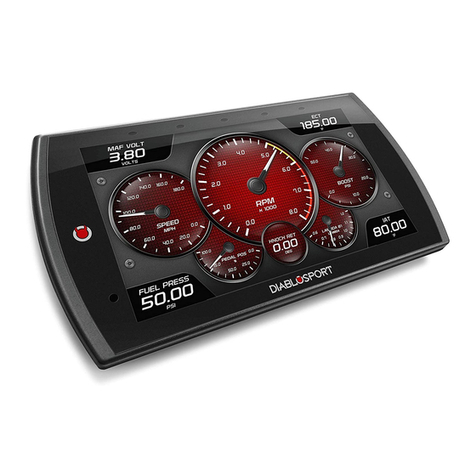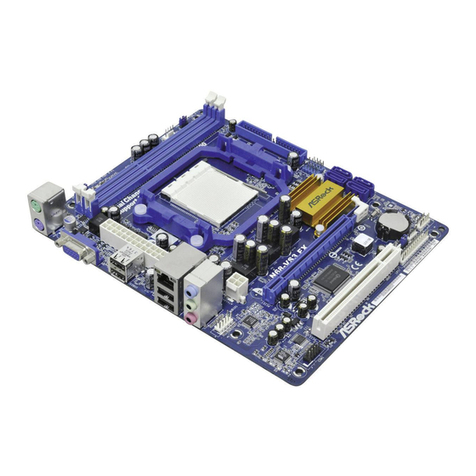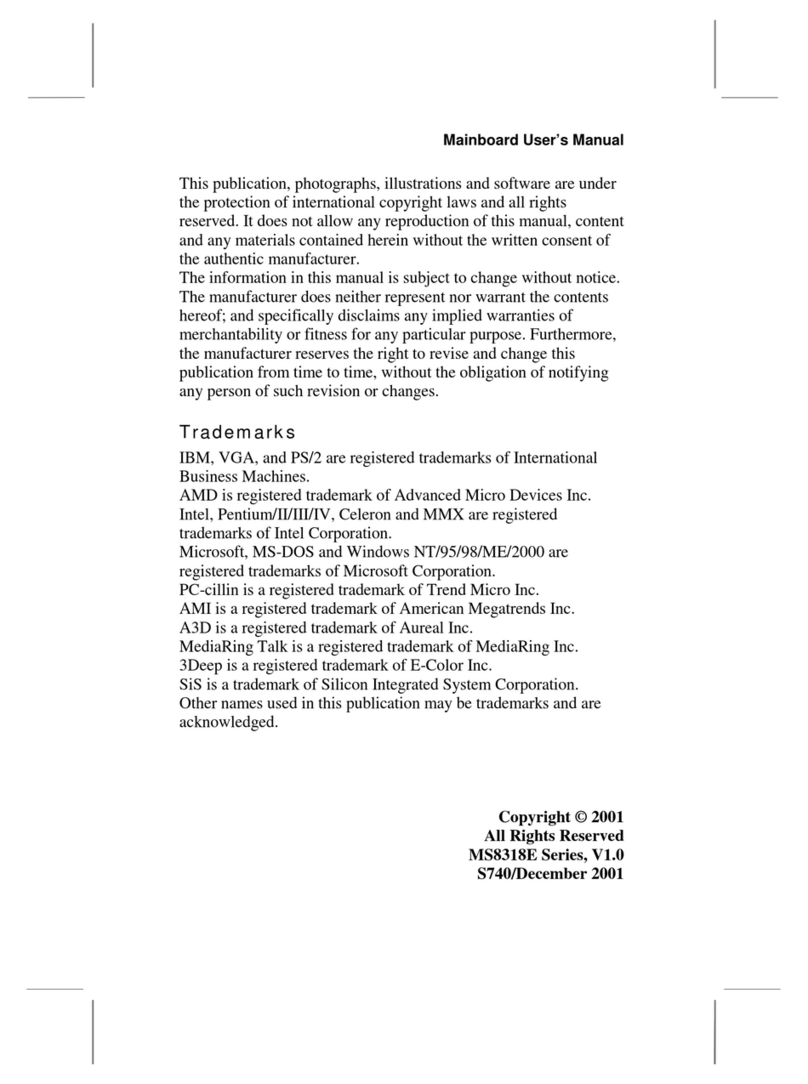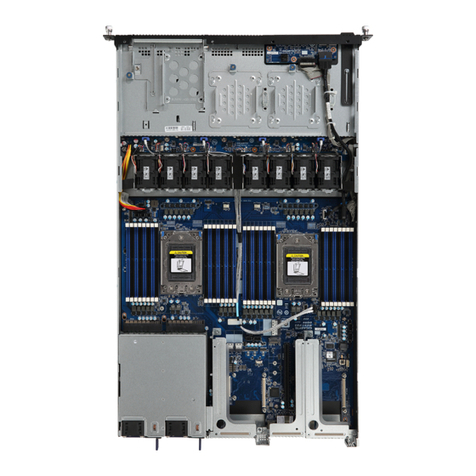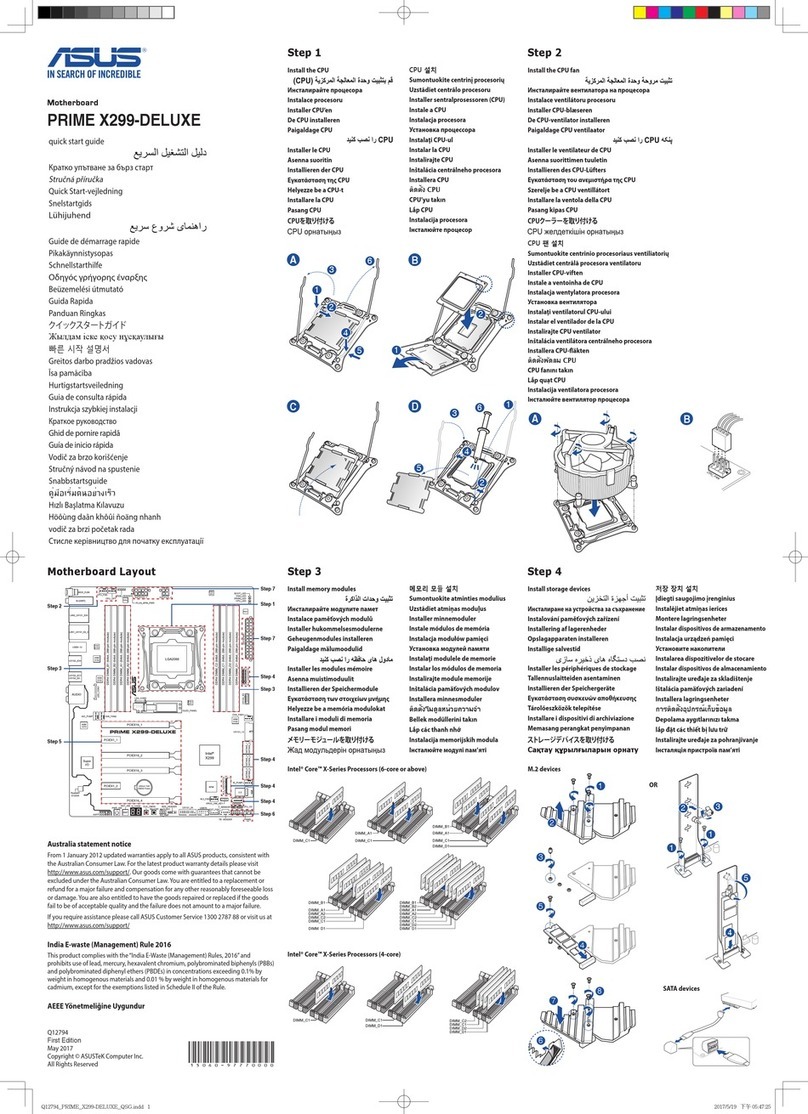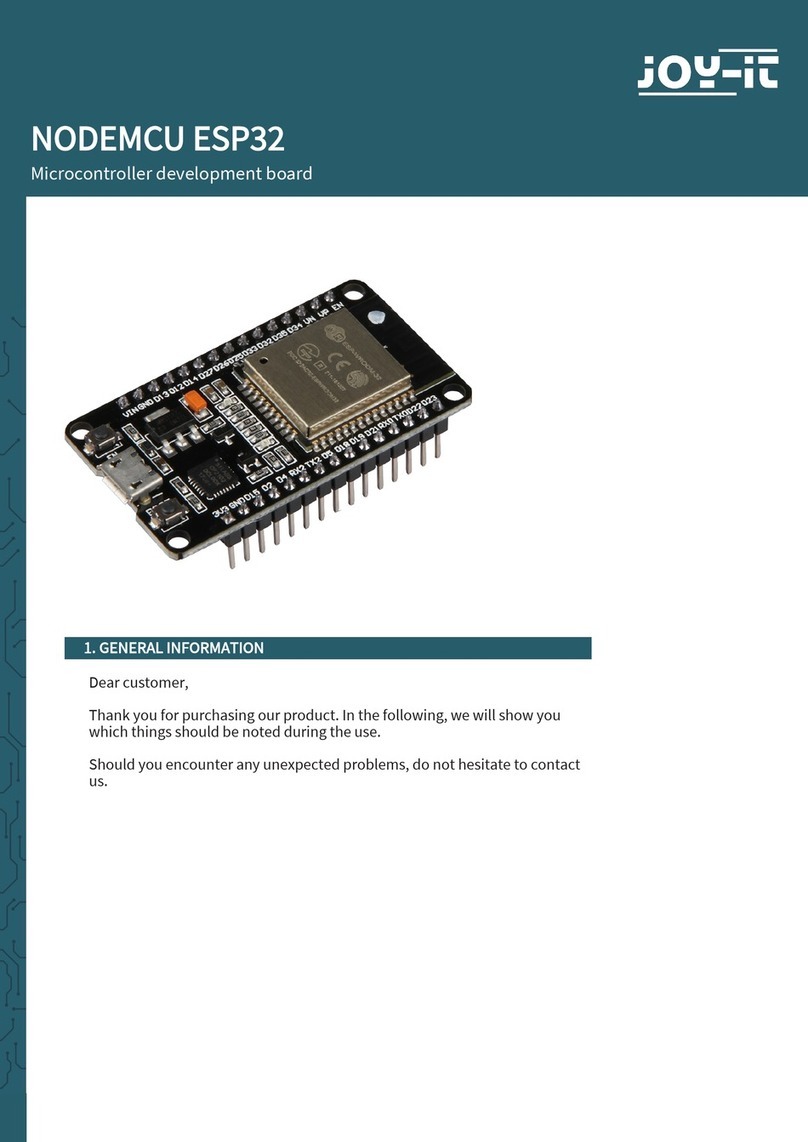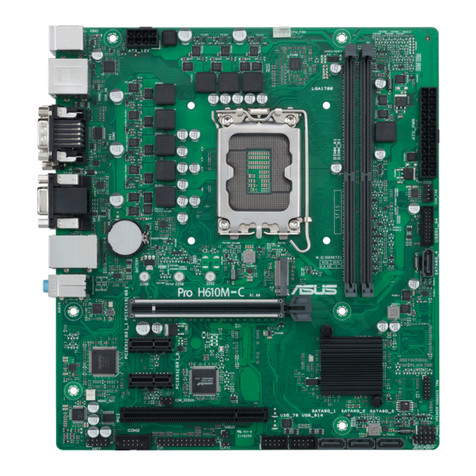IEPC EPC9126 User manual

Development Board
EPC9126/EPC9126HC
Quick Start Guide
EPC2212/EPC2001C
100 V High Current Pulsed Laser Diode Driver
Revision 3.0

QUICK START GUIDE Demonstration System EPC9126xx
EPC – THE LEADER IN GaN TECHNOLOGY | WWW.EPC-CO.COM | COPYRIGHT 2019 | | 2
DESCRIPTION
The EPC9126 and EPC9126HC development boards are primarily intended
to drive laser diodes with high current pulses with total pulse widths < 3 ns
(half amplitude pulse width). The board is shipped with an EPC2212 or
EPC2001C (HC version) enhancement mode (eGaN®) eld eect transistor
(FET). The EPC2212 is an AEC-Q101 automotive qualied 100 V FET capable
of current pulses up to 75 A, and the EPC2001C is a 100 V FET capable
of current pulses up to 150 A. The development boards used the same
printed circuit board with minor component changes in addition to the
dierent FETs. Due to the fact that the basic design and behavior of the
boards is nearly the same, the term EPC9126xx will be used to refer to either
board, and only when necessary will one or the other board be called
attention to. The EPC9126xx ships with the EPC9989 interposer board.
The EPC9989 has a collection of break-away 5 mm square interposer PCBs
with footprints for dierent lasers and a collection of other footprints. The
use of the interposers allows many dierent lasers or other loads to be
mounted while still being able to use the EPC9126xx. The boards do not
include a laser diode, which must be supplied by the user.
The EPC9126xx comprises a ground-referenced eGaN FET driven by a
Texas Instruments LMG1020 gate driver. The EPC9989 interposer provides
multiple options for mounting laser diodes. The printed circuit board is
designed to minimize the power loop inductance while maintaining
mounting exibility for the laser diode or other load. It includes multiple
on-board passive probes for voltages and discharge capacitor current,
and is equipped with SMA connections for input and sensing designed for
50 ohm measurement systems. In addition, the board includes a narrow
pulse generator capable of sub-nanosecond precision, or the user can
simply send the input to the gate drive directly. Finally, the board can also
be used for other applications requiring a ground-referenced eGaN FET,
e.g. Class E ampliers or similar. A complete block diagram of the circuit is
given in gure 1, and a detailed schematic in gure 4.
For more information on the EPC2212C or EPC2001C eGaN FETs,
please refer to the datasheets available from EPC at www.epc-co.com.
The datasheet should be read in conjunction with this quick start guide.
In addition, there is an application note, AN027 eGaN FETs for Lidar –
Getting the Most Out of the EPC9126 Laser Driver. While the note discusses
Rev. 2 of the EPC9126xx, most of the information is applicable to Rev. 3.
SETUP AND OPERATION
Development board EPC9126xx is easy to set up to evaluate the
performance of the EPC2212 or EPC2001C(HC version) eGaN FET. Refer
to Figure 2 for proper connect and measurement setup and follow the
procedure below:
1. Review laser safety considerations. Observe all necessary laser
safety requirements including the use of personal protection
equipment (PPE) as required. Refer to qualied safety personnel
as necessary.
2. With power o, install laser diode U2 or other load. The use of one
of the interposers from the included EPC9989 be used to mount the
laser or other load, and this is discussed in the section Laser Diode and
Load Considerations for further information.
Table 1: Performance Summary (TA= 25°C) EPC9126 and EPC9126HC
Symbol Parameter Conditions Min Nom Max Units
VLogic
Gate drive and
logic supply 6 12 V
VBUS
Bus Input
Voltage Range 0
80
V
ZIN Input impedance 50 Ω
VINPUT Input pulse range 0
5
V
TPin Input pulse width 1 ns
3. With power o, connect the input power supply bus to +VBUS (J2)
and ground / return to –VBUS (J2) or GND.
4. With power o, connect the logic supply (7-12 V VDC) to +VLogic or
GND.
5. With power o, connect the signal pulse generator to the input
J5. J5 is terminated with 50 Ω on the EPC9126, and is designed
for a 5 V logic input. The signal input can handle up to 0.25 W
RMS (3.5 V RMS), which corresponds to a 50% duty cycle at 5 V.
This pulse specication is for the input only, and the user will have
to make informed choices regarding the rest of the circuit.
6. Connect the remaining measurement SMA outputs to an
oscilloscope, using 50 Ω cables and with the scope inputs set
to 50 Ω impedance. See section Measurement Considerations
for more information, including the attenuation values for each
output.
7. Turn on the logic supply voltage to a value within the
specications.
8. Turn on the bus voltage to a value within the specication.
9. Turn on the pulse source and observe switching operation via the
outputs and any additional desired probing. Laser diode output
may be observed with an appropriate electro-optical receiver.
10. Once operational, adjust the bus voltage, input pulse width, and
pulse repletion frequency (PRF) as desired within the operating
range and observe the system behavior.
11. For shutdown, please follow steps in reverse.
NOTE: When measuring the high frequency content switch node, care must be taken
to avoid long ground leads. Measure the switch node by placing the oscilloscope
probe tip through the large via on the switch node (designed for this purpose) and
grounding the probe directly across the GND terminal provided. See Figure 3 for
proper scope probe technique.
SAFETY WARNING: This board is capable of driving laser diodes to
generate high peak power optical pulses. Such pulses are capable of
creating PERMANENT VISION DAMAGE. Laser diodes may emit infrared
(IR) light that is invisible, but which can still cause PERMANENT VISION
DAMAGE. User is fully responsible for following proper laser safety
procedures to prevent vision damage.

QUICK START GUIDE Demonstration System EPC9126xx
EPC – THE LEADER IN GaN TECHNOLOGY | WWW.EPC-CO.COM | COPYRIGHT 2019 | | 3
OPERATING PRINCIPLE
The EPC9126xx is shipped as a capacitive discharge laser diode driver.
Please refer to the block diagram (gure 2) and the schematic (gure 4).
It has several possible modications (section MODIFICATIONS), but only
the basic operation will be covered in this section. The EPC9126xx basic
operating principle is to discharge energy storage capacitance {C10,
C11, C12, C13, C14} through the laser diode, and then recharge {C10,
C11, C12, C13, C14} through the resistor bank {R2, R3, R5, R6}.
The discharge is controlled via an input pulse that is delivered to SMA
connector J5, which is terminated on the demo board with 50 Ω. As
shipped, SW1_6 is turned on, and this pulse is delivered to gate driver
U5. When the input goes high, the gate driver turns on Q1, allowing {C10,
C11, C12, C13, C14} to discharge through the laser diode U2. When the
input goes low, Q1 turns o. If there is current remaining in the power
loop, diodes D1, D2 (if added by user) can conduct and help prevent
overvoltage of the laser and FET.
Measurements of many of the main waveforms can be made through
the SMA test points provided. These test points can provide waveform
measurements with equivalent bandwidths > 3 GHz. As a result, they
have requirements and properties that dier from most conventional
oscilloscope probes. More details on the usage of these test points is
provided in section MEASUREMENT CONSIDERATIONS.
For further details on lidar driver circuits, it is recommended to read
the application note Getting the Most out of eGaN FETs and Your
EPC9126 Laser Driver (AN027), available at www.epc-co.com. While this
application note refers to V2.5 of the EPC9126xx, the basic principles
and design methods are still applicable.
LASER DIODE OR LOAD CONSIDERATIONS
The EPC9126xx can be used as is to mount a laser diode or other
load. Figure 3 highlights the output pad locations. However, many
laser suppliers have dierent mounting footprints, making it dicult
to optimize the performance of the driver and still maintain the
desired exibility. The use of an interposer PCB provides a solution
to this problem with only a small added performance penalty.
The EPC9126xx Rev. 3 ships with the EPC9989 interposer PCB,
shown in gure 4. The EPC9989 has an assortment of 5 mm square
interposer PCBs that can be snapped o the board. These interposers
have various footprints on the top side that can accommodate
several surface mount laser diodes, an MMCX connector, and several
patterns designed to accommodate a wide variety of possible loads.
These interposers mount between the EPC9126xx and the laser diode
or other load. Figure 5 shows an example of an Excelitas SMD laser
diode mounted with one of the interposers.
Figure 1: Block diagram of EPC9126xx development board
C10, 11, C12, C13, C14
R14, R15, R16, R17, R18
Shunt (J6)
VBUS
D1,D2
VOUT (J7)
S1_1 – S1_5
S1_6
Cap (J3)
Input (J5) Narrow pulse
generator VGS (J9)VGDIN
VLogic
U2
Q1
+
+
–
–
Figure 2: Connection and measurement setup
Figure 3: Output terminals of EPC9126xx
Figure 4: EPC9989 interposer PCB
Top
Bottom
SMD lasers MMCX Alternate loads
Breakaway
V-grooves
Laser cathode
(FET drain)
Laser anode
(FET drain)
GND (for alternate
applications)
V7
IN
Laser
diode
or load
Signal generator
V
BUS
+– +–
Oscilloscope
(50 Ωinputs)

QUICK START GUIDE Demonstration System EPC9126xx
EPC – THE LEADER IN GaN TECHNOLOGY | WWW.EPC-CO.COM | COPYRIGHT 2019 | | 4
The recommended use of the interposer is the following:
1. Apply solder paste to the U2 pads on the EPC9126xx PCB.
2. Apply solder paste to the appropriate pads on the top side of the
interposer.
3. Carefully position the desired interposer with the bottom side facing
the top side of the EPC9126xx on the U2 footprint.
4. Position the laser diode or desired load on the interposer.
5. Reow with the recommended temperature prole for the solder
used. The use of a reow oven that can meet the recommended
soldering specications is highly recommended. Other reow
methods may also be used based on the experience of the user.
The power loop inductance, including that of the laser diode, is a primary
factor that determines the shape of the laser pulse. Considerable eort
has been made to minimize power loop inductance while maximizing
the choice of laser diode and its orientation. The discharge caps,
current sense resistors, and the eGaN FET must all be mounted in close
proximity to minimize inductance. As a result, the user must take care
not to damage any components when mounting the laser or changing
other components in the power loop.
Laser diode current pulses can result in peak powers of several hundred
watts to over 1 kW. Laser diodes for lidar applications are designed with
this in mind, but thermal limitations of the laser package mean that
pulse widths, duty cycles, and pulse repetition frequency limitations
must be observed. Read laser diode data sheets carefully and follow any
manufacturers’ recommendations.
This board has been tested with the following laser diodes:
TPGAD1S09H from Excelitas (http://www.excelitas.com).
MEASUREMENT CONSIDERATIONS
SMA jacks are provided to measure several voltages in the circuit, including
gate drive input, Q1 gate voltage, Q1 drain voltage, charge voltage of
the energy storage cap, and the sense voltage of the discharge cap
current measurement shunt. All measurement points are designed to be
terminated in 50 Ω, hence when viewing waveforms, the oscilloscope
inputs should be set to a 50 Ω input. Ideally, unused inputs should be
also terminated with a 50 Ω load to prevent the probes from creating
additional resonances. The Q1 drain voltage and the discharge cap sense
voltage have on-board terminations to greatly reduce this eect, and in
practice, the remaining resonances may be small or otherwise tolerable.
It is recommended that the user verify this for their own requirements.
All sense measurement SMAs, except for the shunt measurement, use the
transmission line probe principle to obtain waveform delity at sub-ns
time scales. They have been veried to produce near-identical results to a
Tektronix P9158 3 GHz transmission line probe. As a result of their design,
they have a built-in attenuation factor. In addition, the impedance of the
probes is relatively small, and as a result, the test points for high voltage
measurements include a DC blocking capacitor. If long pulse widths are
used, these test points may yield erroneous results, and an external probe
should be used.
The current shunt is designed to estimate the discharge capacitor current.
Substantial eort has been made to reduce the inductive eects of the
current shunt, both through the use of carefully selected resistors and a
compensation network to help compensate for the shunt equivalent
series resistance. However, the shunt is a compromise between current
measurement accuracy and minimizing the impact on the laser driver
performance. If a more accurate shunt waveform measurement is desired,
the shunt resistors may be replaced with ones that provide higher accuracy.
This is likely to require higher resistor values, which can contribute to errors
in the capacitor voltage measurement and in increased power dissipation.
Finally, note that the capacitor current also includes the current due to D1
and D2 (if included), and PCB capacitance.
Table 2 summarizes the properties of the SMA test points for ease of
reference.
Table 2: Properties of SMA test points
Designator PCB label Description Attenuation factor DC blocking cap LF time constant Internal 50 Ω
termination
J3 CAP Discharge capacitor voltage
(VCHARGE on schematic) 41 V/V 10 nF 10 μs YES
J6 SHUNT Discharge shunt voltage 21.2 A/V (EPC9126)
45.5 A/V (EPC9126HC) NO N/A NO
J7 VOUT Q1 drain voltage
41 V/V
10 nF 10 μs YES
J9 VGDIN Gate drive input 20 NO N/A NO
J10 VGS Q1 gate voltage 20 NO N/A NO
Laser diode
or load
EPC9989
interposer
EPC9126
eGaN FET
Gate driver
Current
shunt
Discharge
capacitors
Recharging
resistors
Figure 5: Laser mounted to EPC9126xx using interposer

QUICK START GUIDE Demonstration System EPC9126xx
EPC – THE LEADER IN GaN TECHNOLOGY | WWW.EPC-CO.COM | COPYRIGHT 2019 | | 5
OTHER FEATURES
Narrow pulse generator:
Many signal generators cannot produce an accurate, short pulse.
The EPC9126xx includes a function to obtain narrow output pulses, following
a method given in Section 8.2.2.2 of the Texas Instruments LMG1020 data
sheet.This is controlled through DIP switch S1. For normal operation, position
6 should be ON, and the positions 1 through 5 should be OFF. In this case, the
input pulse to J5 will be passed to the gate drive unmodied.
To operation the narrow pulse generator, move position 6 to OFF. The pulse
input to J5 is now a trigger pulse and must be set to at least 60 ns, with at
least 300ns o time between pulses. The pulse width can now be adjusted
via S1 switch positions 1 through 5. For best results, keep position 1 in the
OFF state. For very narrow pulses, the position 1 switch may be turned ON,
but reliable operation cannot be expected. Approximate pulse width values
are summarized in Table 3. Since these values are approximate, user must
verify as necessary.
Switch setting (Pos 1 = OFF) Pulse
width
(ns)
654321
0 0 0 0 0 0 60.4
0 1 0 0 0 0 38.1
0 0 1 0 0 0 18.5
0 1 1 0 0 0 11.5
0001009.3
0101006.6
0011005.5
0111005.1
0000104.9
0100103.4
0010102.9
0110102.4
0001102.1
0101101.9
0011101.7
0111101.2
Switch setting (Pos 1 = ON) Pulse
width
(ns)
654321
0000011.6
0 1 0 0 0 1 1.46
0 0 1 0 0 1 1.32
0 1 1 0 0 1 1.17
0 0 0 1 0 1 0.96
0 1 0 1 0 1 0.65
0 0 1 1 0 1 0.45
0 1 1 1 0 1 0.32
0000110.3
0100110
0010110
0110110
0001110
0101110
0011110
0111110
Table 3: Narrow pulse generator switch settings with S1 Pos 6 = OFF. (a): POS 1 = OFF (recommended). (b) POS 1 = ON (not recommended for reliable operation).
(a) (b)
Modications:
While diodes D1 and D2 can provide some protection to FET Q1 and
laser D3, they have parasitic inductance and capacitance that can reduce
performance at the very fastest speeds. Hence, they are not populated,
and it is left to the user to determine whether they are necessary for a
particular application.
The value of the shunt resistors can be increased up to a point to improve
the discharge cap current sense accuracy. Note that accurate measure-
ment of current while inserting extremely low inductance into the power
loop is extremely challenging, and many factors must be considered.
For the lowest possible inductance, the resistors can be replaced with
copper foil if no sensing is needed.
The value of the energy storage cap {C11, C12, C13, C14, C15} can be
modied as desired, as well as the recharge resistor {R2, R3, R5, R6}.
In the extreme case, the resistor may be reduced to 0 Ω for cases where a
capacitive discharge pulse is not desired.

QUICK START GUIDE Demonstration System EPC9126xx
EPC – THE LEADER IN GaN TECHNOLOGY | WWW.EPC-CO.COM | COPYRIGHT 2019 | | 6
Figure 6: Lidar Pulse Demonstration Board schematic
V5V
6VDC - 12VDC
Logic Supply Regulator
MCP1703T-5002E/MC
5.0 V 250 mA DFN
OUT
GN D
IN
GN D
U1
Logic Suppl
y
Main Supply Input
FD1
Local Fiducials
FD2 FD3
Vlogic
PULSE_IN
SMA SM
D
J5
SMA SMD
J7
100
12
R10
0.47
12
R14
100
12
R22
Vout
V5V
1 μF, 50 V
C2
1 μF, 50 V
C3
1 μF, 50 V
C4
VBUS
100
12
R11
100
12
R23
100 nF, 25 V
C20
0
1 2
R1
Vdrain
Vgate
SMD probe loop
1
TP2
1
TP4
SMD probe loop
1
TP1
VBUS
VCHARGE
SMD probe loo
p SMD probe loop SMD probe loop SMD probe loop
1
TP3
5 pF, 50 V
C15
10
1 2
R9
100 nF, 25 V
C18
100 nF, 25 V
C22
PLS_IN1
100 V 25A 7 mΩ
EPC9126: Q1 = EPC2212
EPC9126HC: Q1= EPC2001C
220 pF, 100 V
C10
220 pF, 100 V
C11
220 pF, 100 V
C12
220 pF, 100 V
C13
220 pF, 100 V
C14
3.9k
1 2
R2
3.9k
1 2
R3
3.9k
1 2
R5
3.9k
1 2
R6
VSHUNT
1μF, 100 V
C5
1μF, 100 V
C6
1μF, 100 V
C7
1μF, 100 V
C8
330 Ω, 700 mA
12
FB2
10 nF, 100 V
C19
953
12
R34
VGDIN VGS
1k
1 2
R19
Gate drive input sense
SMA SMD
J3
100
12
R7
100
12
R8
10 nF, 100 V
C9
1k
1 2
R4
SMA SMD
J6
SMA SMD
J9
SMA SMD
J8 953
12
R33
Gate voltage sense
Shunt voltage sense
Discharge cap voltage sens
e
4.7 μF, 25 V
C1
4-40
HOLE1
4-40
HOLE2
4-40
HOLE3
4-40
HOLE4
1
2
J1
1776113-2
330 Ω, 700 mA
1
2
FB3
CAP
SHUNT
i
Z 50 single core
i
Z 50 single core i
Z 50 single core
i
Z 50 single core
i
Z 50 single core
i
Z 50 single core
i
GD prop delay i
GD prop delay
1
TP6
1
TP5
3x1 0.1" Male Vert
.
1
2
3
J4
Vlogic
VBUS
i
Z 50 single core
i
Z 50 single core
0.47
12
R15
0.47
12
R16
0.47
12
R17
0.47
12
R18
i
High voltage
V5V
1
2
J2
1776113-2
MB1
MB3
MB5
MB7
MB2
MB4
MB6
MB8
Drain voltage sense
100 V 200 mA
D1
EMPTY
100 V 200 mA
D2
EMPTY
100 nF, 16V
C21
1
6
54
3
2
VDD
GND
OUTH
OUTL
IN-
IN+
U4
XLMG1020
1 6
5
43
2
VCCGND
U5
NC7WZ16L6X
1 6
5
43
2
VCCGND
U3
NC7WZ16L6X
0
1
2
R30
EMPTY
8 pF, 50 V
C26
402, 1%
1 2
R25
820, 1%
1 2
R27
1.60k, 1%
1 2
R29
8 pF, 50 V
C24
PLS_IN1
14
3 2
23
1
4
U2
DNP
1
2
3
4
5
6 7
8
9
10
11
12
S1
100
12
R20
EMPTY
100
12
R21
5 pF, 50 V
C23
5 pF, 50 V
C25
10
1 2
R26
10
1 2
R28
200, 1%
1 2
R24
3.24k, 1%
1 2
R31
10
1 2
R32
5 pF, 50 V
C16
EMPTY
5 pF, 50 V
C17
EMPTY
i
Z 50 single core
330 Ω, 700 mA
12 FB1
V5V
49.9
1 2
R12
Capacitor Recharge
Discharge capacitor
Pulse current shunt
Laser (or alternate load)
Optional drainclamp
Gate drive
Input pulse processing
0
1 2
R13
HC: C10-C14 = 560 pF
HC: R14-R18 = 0.22

QUICK START GUIDE Demonstration System EPC9126xx
EPC – THE LEADER IN GaN TECHNOLOGY | WWW.EPC-CO.COM | COPYRIGHT 2019 | | 7
Table 4: Bill of Materials - EPC9126xx
Item Quantity Reference Part Description Manufacturer Part Number
1 1 C1 Capacitor, 4.7 μF, 25 V, X5R
TDK
C1608X5R1E475K080AC
2 5 C10, C11, C12, C13, C14 Capacitor, 220 pf, 100 V, NP0 (EPC9126)
Capacitor, 560 pf, 100 V, NP0 (EPC9126HC)
TDK
C1005C0G2A221J050BA (EPC9126)
C1005C0G2A221J050BA (EPC9126HC)
3 3 C15, C23, C25 Capacitor, 5 pf, 50 V, NP0
TDK
C1005C0G1H050C050BA
4 2 C16, C17 Capacitor, 5 pf, 50 V, NP0
TDK
C1005C0G1H050C050BA
5 3 C18, C20, C22 Capacitor, 100 nf, 25 V, X7R
TDK
C1005X7R1E104K050BB
6 3 C2, C3, C4 Capacitor, 1 μF, 50 V, X7R
Taiyo Yuden
UMK107AB7105KA-T
7 1 C21 Capacitor, 100 nf, 16 V, X5R
TDK
C0510X5R1C104M030BC
8 2 C24, C26 Capacitor, 8 pf, 50 V, NP0
Murata
GRM1885C1H8R0BA01D
9 4 C5, C6, C7, C8 Capacitor, 1 μF, 100 V, X7R
TDK
CGA4J3X7S2A105K125AE
10 2 C9, C19 Capacitor, 10 nf, 100 V, NP0
TDK
C1608C0G2A103J080AC
11 3 FB1, FB2, FB3 Ferrite bead, 330 Ω, 700 mA
TDK
MPZ1005S331ET000
12 2 J1, J2 Board to wire connector, 2 position
Tyco Electronics
1776113-2
13 6 J3, J5, J6, J7, J8, J9 Female SMA SMD
Molex
0732511350
14 1 J4 Header, 3x1 0.1 Male Vert.
Tyco
68001-236HLF
15 1 Q1 100 V 18A 13.5 mΩ (EPC9126)
100 V 25A 7 mΩ (EPC9126HC)
EPC
EPC2212 (EPC9126)
EPC2001C (EPC9126HC)
16 1 R1 Resistor, 0, 0402
Panasonic
ERJ-2GE0R00X
17 2 R10, R11 Resistor, 100, 1%, 0603
Vishay
MCT0603MC1000FP500
18 1 R12 Resistor, 49.9, 1% 0402
Panasonic
ERJ-2RKF49R9X
19 1 R13 Resistor, 0, 0402
Panasonic
ERJ-2GE0R00X
20
5
R14, R15, R16, R17, R18 Resistor, 0.47, 1%, 0402 (EPC9126)
Resistor, 0.22, 1%, 0402 (EPC9126HC)
Rohm UCR01MVPFLR470 (EPC9126)
UCR01MVPFLR220 (EPC9126HC)
21
4
R2, R3, R5, R6 Resistor 3.9 k, 1% 0402
Panasonic ERJ-P08J392V
22 1 R24 Resistor 200, 1%, 0402
Stackpole RMCF0402FT200R
23
1
R25 Resistor 402, 1% 0402
Stackpole RMCF0402FT412R
24
1
R27 Resistor 820, 1% 0402
Stackpole RMCF0402FT806R
25
1
R29 Resistor 1.60 k, 1% 0402
Stackpole RMCF0402FT1K60
26
1
R31 Resistor 3.24 k, 1% 0402
Stackpole RMCF0402FT3K24
27
2
R33, R34 Resistor 953 1% 0402
Panasonic ERJ-2RKF9530X
28
2
R4, R19 Resistor, 1 k, 1%, 0603
Vishay PHP00603E1001BST1
29
5
R7, R8, R21, R22, R23 100 1% 0402
Panasonic ERJ-2RKF1000X
30
4
R9, R26, R28, R32 10 1% 0402
Panasonic ERJ-2RKF10R0X
31 1 S1
DIP switch, 6 pos SPST, SOIC
Nidec Copal Electronics CHS-06TA
32 6 TP1, TP2, TP3, TP4, TP5, TP6
SMD probe loop
Keystone 5015
33 1 U1
LDO, 5.0 V 250mA DFN
Microchip MCP1703T-5002E/MC
34 1 U2
Laser
User supplied User Supplied
35 2 U3, U5
UHS dual buer
Fairchild NC7WZ16L6X
36 1 U4
Gate driver
Texas Instrument LMG1020
Table 5: Optional Components
Item Quantity Reference Part Description Manufacturer Part Number
1 2 D1, D2 User selected
User selected
User selected
2 1 R20 Resistor 100 1% 0402
Panasonic
ERJ-2RKF1000X
3 1 R30 Resistor 0 1% 0402
Panasonic
ERJ-2GE0R00X

Demonstration Board Notication
The EPC9126xx board is intended for product evaluation purposes only and is not intended for commercial use. Replace components on the Evaluation Board only with those parts shown on the
parts list (or Bill of Materials) in the Quick Start Guide. Contact an authorized EPC representative with any questions.
This board is intended to be used by certied professionals, in a lab environment, following proper safety procedures. Use at your own risk.
As an evaluation tool, this board is not designed for compliance with the European Union directive on electromagnetic compatibility or any other such directives or regulations. As board builds
are at times subject to product availability, it is possible that boards may contain components or assembly materials that are not RoHS compliant. Ecient Power Conversion Corporation (EPC)
makes no guarantee that the purchased board is 100% RoHS compliant.
The Evaluation board (or kit) is for demonstration purposes only and neither the Board nor this Quick Start Guide constitute a sales contract or create any kind of warranty, whether express or
implied, as to the applications or products involved.
Disclaimer: EPC reserves the right at any time, without notice, to make changes to any products described herein to improve reliability, function, or design. EPC does not assume any liability arising out of
the application or use of any product or circuit described herein; neither does it convey any license under its patent rights, or other intellectual property whatsoever, nor the rights of others.
EPC Products are distributed through Digi-Key.
www.digikey.com
For More Information:
Please contact info@epc-co.com
or your local sales representative
Visit our website:
www.epc-co.com
Sign-up to receive
EPC updates at
bit.ly/EPCupdates
or text EPC to 22828
This manual suits for next models
1
Table of contents
Other IEPC Motherboard manuals
